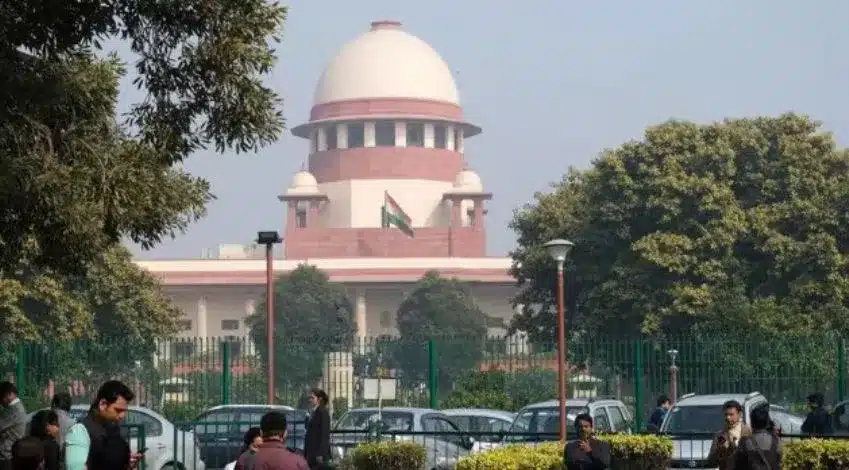What’s in today’s article?
- Why in News?
- Right to environment in India constitution
- Stubble burning
- Key highlights of the observation made by SC
Why in News?
Recently, the Supreme Court raised concerns over the ongoing issue of stubble burning in Punjab and Haryana. The court condemned the selective enforcement of penalties, describing it as a violation of citizens’ fundamental right under Article 21 of the Indian Constitution to live in a pollution-free environment.
Right to environment in India constitution
- Right to life under Article 21
- The Supreme Court in Subhash Kumar v. State of Bihar, 1991 held that Article 21 includes the right to a wholesome environment.
- This position was again reaffirmed in Virender Gaur v. State of Haryana,1994.
- Directive Principle of State Policy
- Article 48A puts a duty on the State to protect and improve the environment and further to safeguard the forests and wildlife.
- In Sher Singh vs State of Hp 2014, the National Green Tribunal held that the State is under a constitutional obligation to protect and improve the environment.
- In M.C. Mehta vs Union of India, 2002, the court held that Article 39(e), 47 and 48A collectively cast a duty on State to secure public health and environment protection.
- Fundamental Duties
- Article 51A(g) puts a fundamental duty on the citizens to protect and preserve the environment.
Stubble Burning
- Why Farmers opt for Stubble Burning?
- Rice and wheat straws left in the field, after combine harvesting, are generally burnt by the farmers to facilitate seed bed preparation and seeding.
- Farmers find this method as quick and cheap compared to other practices for crop residue management.
- Since input costs of farming is going up day by day, farmers are not willing to further invest in equipments useful for crop residue management.
- Happy Seeder (a tractor-operated machine for in-situ management of paddy stubble) continues to be an expensive method for majority of farmers.
- Areas where this practice is rampant
- Burning of agricultural residue is done on a large-scale basis in states such as Punjab, Haryana, Uttar Pradesh, Rajasthan and National Capital Region of Delhi.
- This is prevalent in other states too. This includes: Bihar, Odisha, West Bengal etc.
- Impact
- Environmental Pollution
- Agriculture fires are a major contributor to air pollution in north India in October-November.
- Pollutants from these fires spread across the region, triggering smog and extreme air quality situations.
- An increase in the concentration of particulate matter (PM) 2.5 and PM 10 in the atmosphere is observed in these months.
- Harmful to the health of soil
- Burning of crop residues removes huge amount of nutrient from the soil.
- Practices like residue burning has further reduced the organic carbon content in soil.
- Environmental Pollution
Steps Taken by the government to tackle the issue of farm fires
- Taken by Centre
- A Central Sector Scheme on ‘Promotion of Agricultural Mechanisation for In-Situ Management of Crop Residue in the States of Punjab, Haryana, Uttar Pradesh and NCT of Delhi’ was approved.
- Farmers are being provided 50 percent of the cost of machinery/equipment as financial assistance for the purchase of such machinery.
- The central government has released Rs 3,062 crore to the governments of Punjab, Delhi and states in NCR during the five-year period from 2018 to 2023 towards effective management of stubble.
- Profit from the left-over biomass is shared with farmers.
- Pusa Decomposer by Indian Agricultural research Institute (IARI)
- The Pusa decomposer is a bio-enzyme developed by the Indian Agricultural research Institute (IARI) to decompose crop residue.
- It decomposes stubble within 20-25 days after spraying and turn it into manure, improving the soil quality.
- Taken by State Governments and Other agencies
- States governments and other agencies are sensitising farmers on healthier practices.
- The Punjab government had proposed to provide cash incentives to farmers for not burning stubble.
- It also decided to provide non-fiscal incentives to these industries in terms of availability of Panchayat land for storage of paddy straw with lease agreement upto 33 years.
Key highlights of the observation made by SC
- Fundamental Right to a Pollution-Free Environment
- The Supreme Court emphasized that every citizen has a fundamental right under Article 21 of the Indian Constitution to live in a pollution-free environment.
- It stressed that violations of this right go beyond mere implementation of laws, highlighting the blatant infringement of fundamental rights.
- Section 15 of the Environment Protection Act Rendered “Toothless”
- The court criticized the ineffectiveness of the amended Section 15 of the Environment Protection Act-1986, which replaced criminal penalties with financial penalties for environmental violations.
- This provision has become “toothless” due to the Centre’s failure to establish necessary support systems, such as framing rules and appointing adjudicating officers, even after six months of the amendment’s enactment.
- Inadequate Enforcement Mechanism
- The absence of appointed adjudicating officers prevents law enforcement from imposing penalties under the amended Section 15, leaving environmental violations unpunished.
Q.1. Why did the Supreme Court criticize Punjab and Haryana over stubble burning?
The court noted selective penalties, where only a few violators faced consequences, despite widespread stubble burning. This inconsistent enforcement infringes on citizens’ right to a pollution-free environment, a fundamental right under Article 21 of the Indian Constitution.
Q.2. What are the consequences of stubble burning in northern India?
Stubble burning contributes significantly to air pollution in northern India during October and November. It increases particulate matter, impacting air quality and health, and depletes soil nutrients, necessitating stricter enforcement of environmental laws.
Source: Supreme Court pulls up Centre: Every citizen has right to environment free of pollution | iPleaders | The Hindu
Last updated on August, 2025
→ UPSC Mains Question Paper 2025 is out for Essay, GS 1 & GS 2.
→ UPSC Mains GS 3 Question Paper 2025 is now out.
→ UPSC Mains GS 4 Question Paper 2025 is now out.
→ UPSC Mains 2025 will be conducted on 22nd August 2025.
→ UPSC Notification 2025 was released on 22nd January 2025.
→ UPSC Calendar 2026 is released on 15th May, 2025.
→ UPSC Prelims Question Paper 2025 and Unofficial Prelims Answer Key 2025 are available now.
→ UPSC Prelims Result 2025 is out now for the CSE held on 25 May 2025.
→ The UPSC Vacancy 2025 were released 1129, out of which 979 were for UPSC CSE and remaining 150 are for UPSC IFoS.
→ UPSC Prelims 2026 will be conducted on 24th May, 2026 & UPSC Mains 2026 will be conducted on 21st August 2026.
→ The UPSC Selection Process is of 3 stages-Prelims, Mains and Interview.
→ UPSC Result 2024 is released with latest UPSC Marksheet 2024. Check Now!
→ UPSC Toppers List 2024 is released now. Shakti Dubey is UPSC AIR 1 2024 Topper.
→ Also check Best IAS Coaching in Delhi














